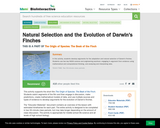
In this lesson, students use technological equipment to better study and document genetics in fruit flies.
- Subject:
- Science
- Material Type:
- Lesson Plan
- Provider:
- Digital Wish
- Date Added:
- 05/03/2018

In this lesson, students use technological equipment to better study and document genetics in fruit flies.

In this activity, students study a graph illustrating the proportion of prey captured by three predators for each of six species of arthropod prey. The prey species are listed in order of palatability (based on a combination of all defenses, such as spines and chemicals) with the least palatable on the left and most palatable on the right. Students will analyze the graph and answer a series of questions to determine if members of a mimetic complex enjoy greater protection from predation than nonmimics.

This module includes hands-on and inquiry-based activities related to the processes of meiosis and gamete formation. Using yarn and pop beads, students will simulate the changes in chromosome pairs during the various stages of meiosis. The students will use Playdough to model the formation of the sperm and egg cells. Students will denote the differences in cytokinesis and explain the reasoning for the differences.

This module provides three different methods for learning about mitosis and includes hands-on, inquiry-based activities. Students will prepare and examine slides of their cheek cells and compare them to those of other students. This will demonstrate the relationship between the structure and function of cells and the similarity of the same types of cells within the same species. Using yarn and popsicle sticks, students will model and explain each of the stages of mitosis. The students will observe prepared slides of onion root tips and whitefish blastula to discover the differences in mitosis in plant and animal cells.

In this activity, students are given a habitat card and then identify and arrange the appropriate species in a food chain. They then indicate how each species affects the species in the trophic level below it in order to illustrate a trophic cascade.

Students will become Linnaeus by dividing into groups to create their own "Six Kingdom" classification system using various types of fasteners. They will group the fasteners based on similar characteristics and divide them into domains, kingdoms, phyla, classes, orders, families, genera, and species. They will also have to "name" each taxon for their classification system as well as give the scientific name for each "species" of a fastener.

This resource is a compilation of text, videos, and other elements to create a scaffolded 5E learning experience for students. In this lesson, students will identify some changes in genetic traits that have occurred over several generations through natural selection and selective breeding.

This lesson supports viewing of the short film The Beak of the Finch. Students watch segments of the film and then engage in discussion, make predictions, create mathematical models of data, and use multiple sources and types of evidence to develop arguments for the evolution of Darwin’s finches.

In this lesson, students will analyze Ebola sequences that were obtained from patients in Sierra Leone during the 2013–2016 outbreak in West Africa. Students are challenged to place sequences into groups based on similarities to determine the transmission history of the virus. Students then compare their results to those of scientists at the Broad Institute of MIT and Harvard, who followed a similar procedure at the beginning of the outbreak. This lesson is meant to be used in conjunction with the video: "Natural Selection in an Outbreak."

This video illustrates how evolution happens through selection.

Students will take on the role of both research biologists and predators to simulate how envrionmental conditions affect and change a population of model frogs and traits. Students will encounter the impacts of mutations and changes to the environment affecting the survival as well.

Students investigate how, through the process of evolution, animals have solved their engineering problems and how people have mimicked those natural solutions.

Students will learn how reesearchers are studying the connection between nest behaviors and the survival and growth rates of Carolina Chickadees.

During this extended unit, students will explore environmental sustainability from a number of different perspectives. They will dive deep into global policies regarding the environment, specifically the dedication of different countries to the Millennium Development Goals (MDGs). Students will review and discuss specific case studies, offering their opinion of certain practices and policies. As a summative assessment, students will create a “Call to Action†project, with the intent of raising awareness and instigating action on environmental sustainability. This unit includes language (objectives, vocabulary, and lesson modifications) that will help the teacher meet the needs of ELL students. These strategies may be helpful for other students, as well.

In this unit, students will investigate the effect of epidemics on populations and the ways in which epidemic models can clarify the spread of disease for the general public. Students will research a specific epidemic and then suggest a model for demonstrating the spread of the disease.

The goal of this chapter is to help students understand the science concepts involved in immune response and in new technologies for manufacturing vaccines, as well as the exciting career opportunities available in this field. This chapter also is intended to provide a snapshot of some of the leading vaccine research and manufacturing efforts in North Carolina.

In this activity, students are introduced to real-world examples of niche partitioning and cutting-edge technology used to give unprecedented insights into the feeding habits of wild animals.

This lesson plan includes several hands-on, inquiry-based lab activities exploring the concepts of osmosis and diffusion. The lesson plan is divided into three modules. First, the teacher will demonstrate osmosis and diffusion using gummy bears, salt, celery, food coloring, and hot and cold water. Next, students will participate in a hands-on lab activity that will demonstrate diffusion using various concentrations of corn starch and Lugol's solution. Lastly, students will demonstrate the process of osmosis using dialysis tubing, sucrose solution, cornstarch, phenolphthalein, ammonia, vinegar, and universal indicator solution.

This online tutorial explains and describes osmosis and tonicity.

A blindfolded student "listener" is placed in the middle of a circle of other students who all have different sound makers. The listener must attempt to point in the direction he/she hears the sound. Other students may have such titles as Data Recorder and Soundmaker. Variables such as allowing the listener to turn or not turn his/her head/body are included. There is a separate teacher guide, student guide and an extensive article of background information that discusses the physiology of how our bodies hear and interpret sound. Suggestions for extending this activity are included, as well.